Family : Brassicaceae

Text © Prof. Pietro Pavone

English translation by Mario Beltramini
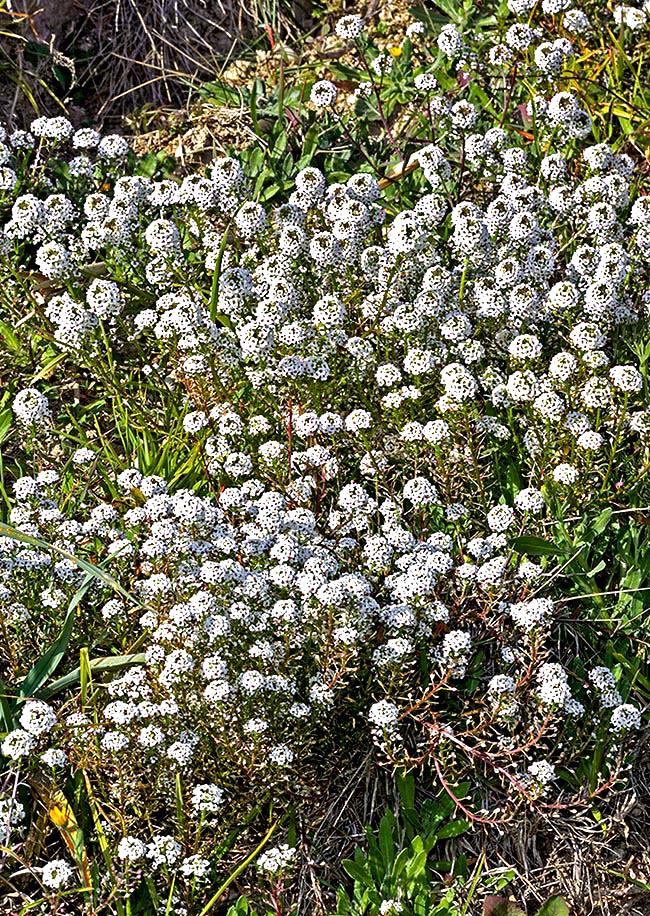
Lobularia maritima spontaneous blooming in the Principality of Monaco inland © Giuseppe Mazza
Lobularia maritima (L.) Desv. is a species belonging to the family Brassicaceae, tribe Anastaticeae, native to the coastal areas of western Mediterranean, of Macaronesia and of the Bay of Biscay.
However, this species has amply naturalized in the temperate climates of all the world because it has escaped cultivation.
It lives in the rocky and sandy soils, beaches, dunes and screes, cultivated fields, walls, from the sea level up to about 300 m, even if, at times, it can reach 1200 m of altitude.
The term Lobularia originates from the Larin “lobulus”, small lobe, with reference to the rounded shape of the silicles. The specific epithet maritima comes from sea, because, usually, it grows near the sea.
It is commonly called Sweet alison or Sweet alyssum. This name comes from the genus Alyssum to which, yore, this taxon was ascribed.
Lobularia maritima is formed by perennial herbaceous plants, suffruticose at times, (5-)12-24 (-40) cm tall, pubescent.
The roots are robust and at times very elongated in the ground. The stems are erect, ascending, procumbent or decumbent, ramified at the base.
The leaves are pubescent, linear, lanceolate, the cauline, sub spatulate or oblanceolate, the basal, and usually measure 1,5-2,5 cm x 1,5-3 mm, with attenuated base, entire margin and normally sharp apex.
The flowers are arranged in dense racemes, usually not very leafy.
The 5-7 mm fructiferous pedicels are ascending, straight, pubescent. The sepals are 4, oblong (1,5-1,8 c 0,5-1 mm) and pubescent, of green or purple colour. The petals are 4, white or violet, obovate or suborbicular (2-3x 1,5-2,5 mm), narrowed to claw of 1 mm. The stamens are 6 tetradynamous, that is, 4 long and 2 lateral ones, shorter. The (1,2-2 mm) staminal filaments are white or violet and the anthers (0,3-0,5 mm) are ovate. The style measures 0,4-0,6 mm in the fruit that is an ovate, elliptical or orbicular, normally 2,3-4 x 1,5-2 mm silicle.
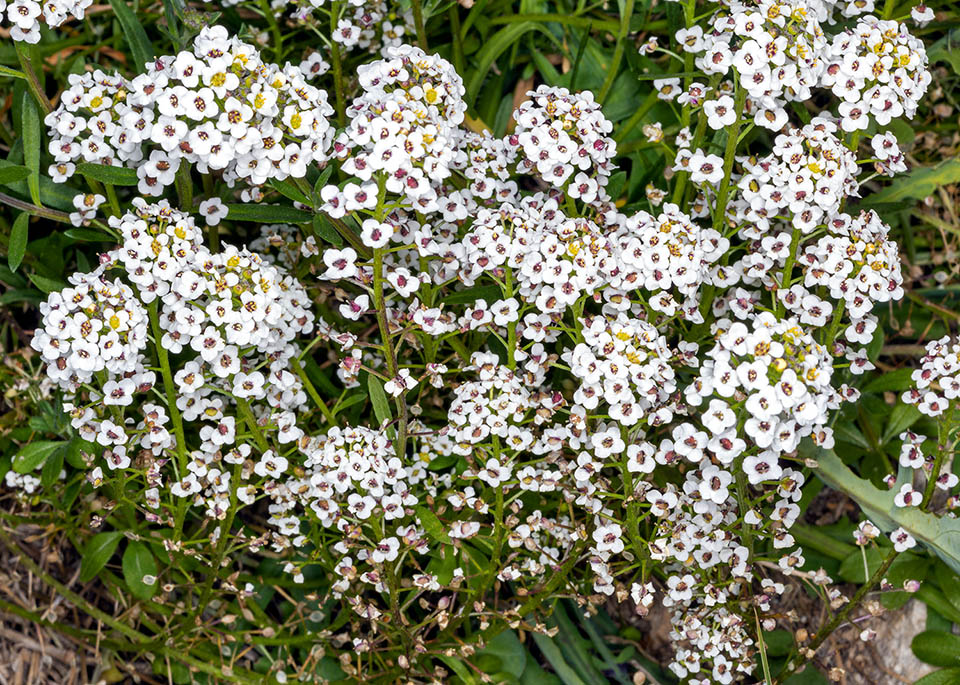
Native to the western Mediterranean coasts, Macaronesia and Bay of Biscay, it is a species now naturalized in the temperate climates of all the world © Giuseppe Mazza
The seeds, of pale brown or, at times, reddish, colour are 2, one per cavity of each silicle with the replum persisting for a long time on the axis.
The seeds have a lenticular shape, without wings or with a narrow wing up to 0,1 mm of breadth. Their dispersion is carried out by the wind (anemochory).
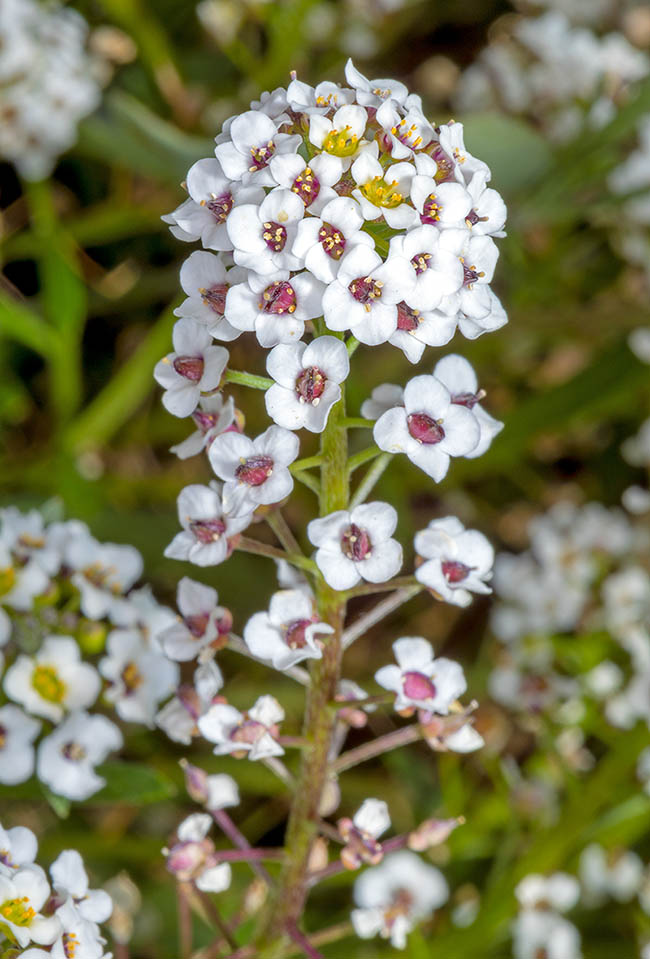
Edible plant with spicy taste with medicinal virtues, has a sweet nectar that attracts bees, butterflies and other pollinating insects with elegant racemes that may exceed the 20 cm of height. The petals are white or violaceous © Giuseppe Mazza
Blooming takes place from March to September but even all the year round in frost-free locations.
Thanks to their appealing colours, the flowers of Lobularia maritima attract many pollinators and useful insects.
As a matter of fact, the pollination is carried out by bees, butterflies, moths, flies and even by some coleopterans, whilst the sweet smell of the nectar attracts the syrphids.
The diploid chromosome number is 2n = 24.
The subspecies Lobularia maritima subsp. columbretensis R.Fern. is endemic to the Columbretes Islands (Spain) of volcanic origin.
This subspecies differs from the species due to the flowers having bigger petals, about 3,5-4,1 x 2,5-3,8 mm with a longer nail (1,0-1,5 mm).
Moreover, all the specimens living in Columbretes have suffruticose stems and branches (camephytic habitus).
Conversely, the leaves do not show valid diagnostic differences.
This subspecies has evolved, most probably, due to a process of peripatric speciation, happened in these islands with peculiar bioclimatic and edaphic characteristics, reinforced by the genetic isolation of about 1 million years.
In Sicily is present Lobularia libyca (Viv.) Meisn., species similar but annual, with leafy raceme, persistent sepals and silicles having 3-5 seeds.
Lobularia maritima (L.) Desv. is an important ornamental plant amply cultivated all over the world.
In the northern USA it has been reported as a cultivated plant since 1856.
Often escaped cultivation, it has naturalized in North America byt the end of the nineteenth century. It grows in the sun as well as in the partial shade, is resistant to drought and has appealing and fragrant flowers that taste of honey.
Many cultivars present in the nursery gardening market are known, here below we mention some of them.
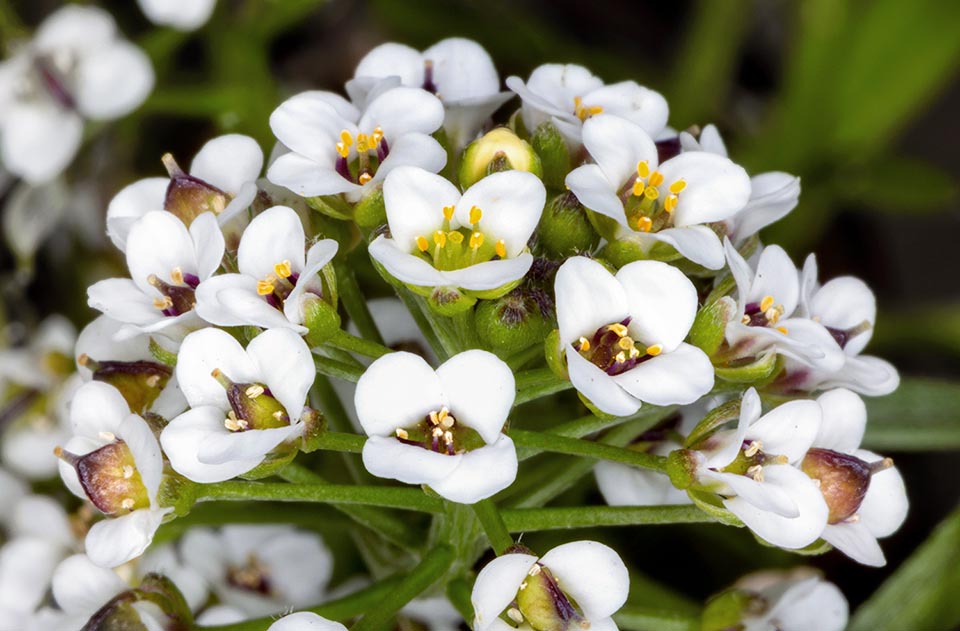
Detail of an inflorescence. We note 6 stamens of different length, called tetradynamous, 4 long and 2 lateral shorter, and growing fruits with showy styles© Giuseppe Mazza
Lobularia maritima ‘Violet Queen’ is a cultivar with deciduous leaves characterized by lilac-violet flowers, sweetly scented and persistent with their prolonged flowering. Suitable for being cultivated in the rocky gardens, in the cracks of dry-stone walls, in the pots on terraces.
Lobularia maritima ‘Nuit d’Orient’ is a low size cultivar, about 10 cm, with purple to violet flowers.
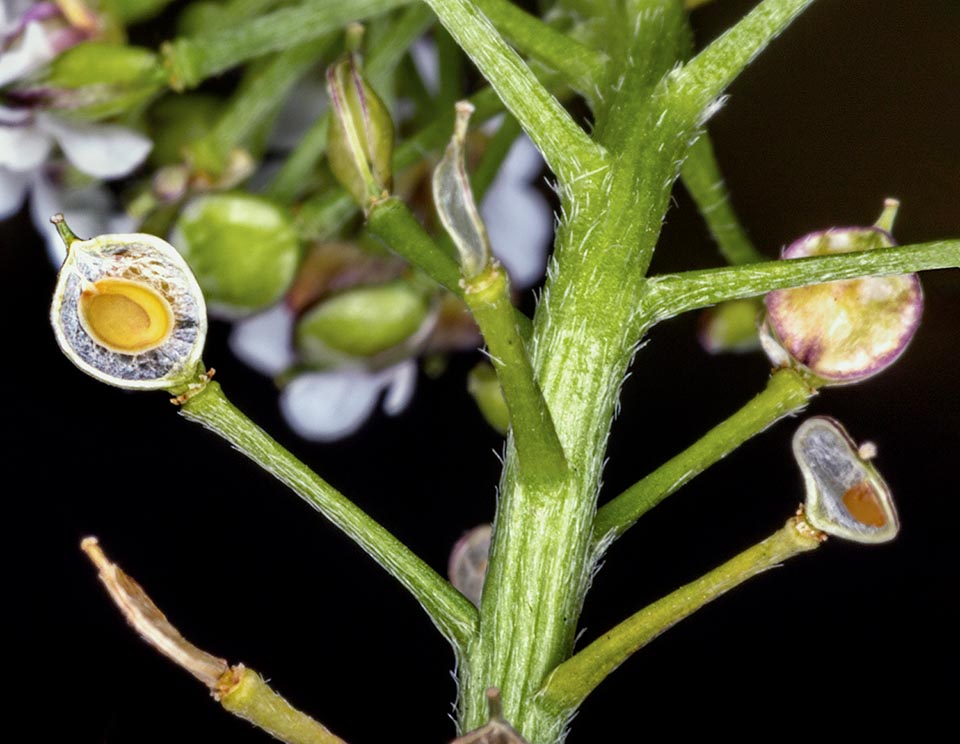
The fruits, flat and roundish, are silicles having 2 seeds. The one just opened, left, is surrounded by the placental frame called replum © Giuseppe Mazza
Lobularia maritima ‘Lavender Stream’ is a very versatile cultivar, up to 30 cm tall, suitable for hanging baskets or for coverings of the soil but each seedling requires a free space around of 30-45 cm. The flowers are abundant, fragrant, of lavender purple colour and persist for a long time on the plant the whole season.
Lobularia maritima ‘Purple Royal Carpet’ is a very compact cultivar and forms a thick carpet completely covered by clusters of small dark violet flowers emitting a very sweet scent. Its blooming attracts a remarkable quantity of bees and butterflies.
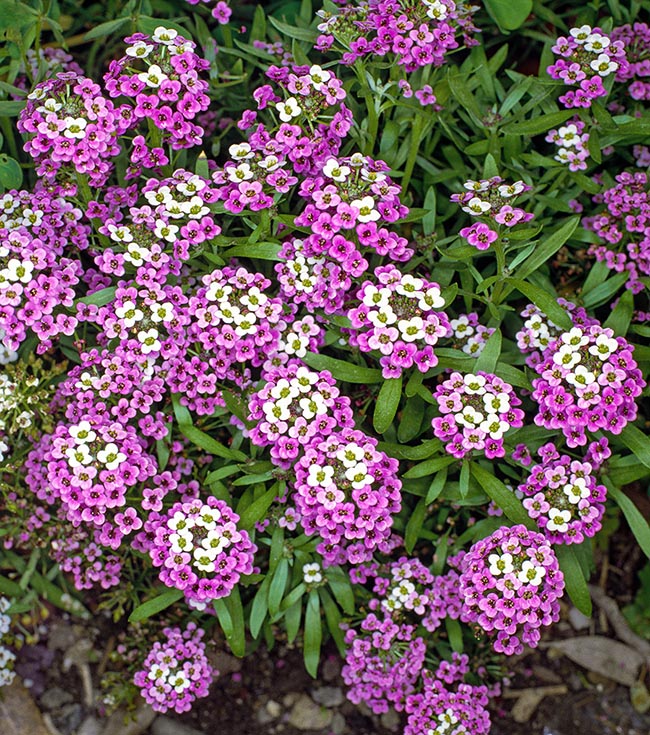
Lobularia maritima ‘Violet Queen’ © Giuseppe Mazza
Lobularia maritima ‘Wonderland Copper’ is a small (7-10 cm) cultivar with compact posture. Has perfumed flowers of pink colour with yellow hues that confer the plant a luminous look.
Lobularia maritima ‘Benthamii’ produces racemes of white flowers. It has simple leaves, oblanceolate and sessile of grey green colour.
Lobularia maritima ‘Easter Bonnet Violet’ is an annual tufty cultivar up to 15 cm tall and in summer has a profusion of sweetly scented violet flowers.
Lobularia maritima ‘Carpet of Snow’ is an annual cultivar, easy to grow from sowing, suitable for ground covering, shaped like a mat, and to realize borders. The plants are 10 cm tall and blooming starts in spring until the winter frosts. The flowers are white, very ornamental, and their scent of honey attracts bees and butterflies.
Lobularia maritima ‘Citrinum’ reaches a height of 20/30 cm and produces pale yellow flowers.
Lobularia maritima ‘Plenum’ is a rather rare cultivar reaching the height of 30 cm and produces double flowers, of bright yellow colour.
Lobularia maritima is an edible species with medicinal properties: astringent, diuretic and antiscorbutic.
The young leaves, the stems and the flowers may be utilized as dressing in salads and in mixed vegetables, in particular dishes where their spicy smell and taste are required.
The propagation of Lobularia maritima is done, in spring, by sowing on a well-drained soil, slightly acidic to neutral. The germination occurs when the temperature is over 10-12 °C. As soon as the seedlings are born, they must be thinned out by 20-80 cm, depending on the cultivars, to give them vital space.
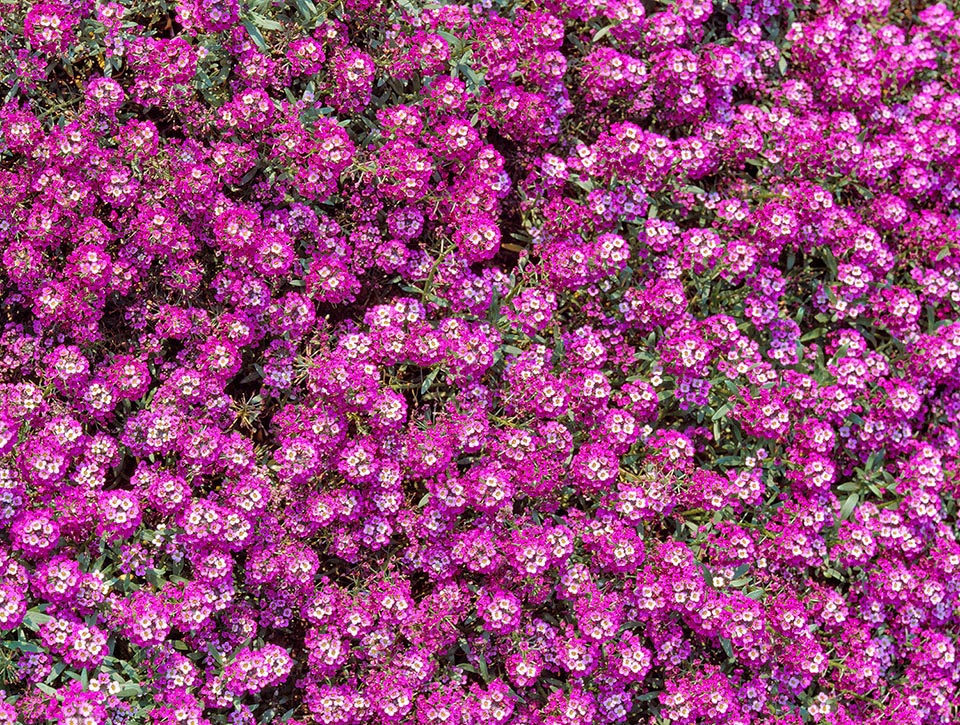
Nursery men worked on the violaceous flowers varieties getting intense hues, tending to red purple, present in various cultivars with elegant contrasts of colours © Giuseppe Mazza
The fertilization is to be done using a fertilizer for flowering plants, granular or liquid, this last diluted in the water used for the irrigations. The administration of too much nitrogen must be avoided. If in the soil the magnesium is missing, it is to be used the magnesium sulfate (0,025%) for 1-2 times, whilst in case of lack of iron, is to be utilized iron chelate for one-two times. This species is resistant to drought; therefore, the irrigations are to be done only in summer with dry soil.
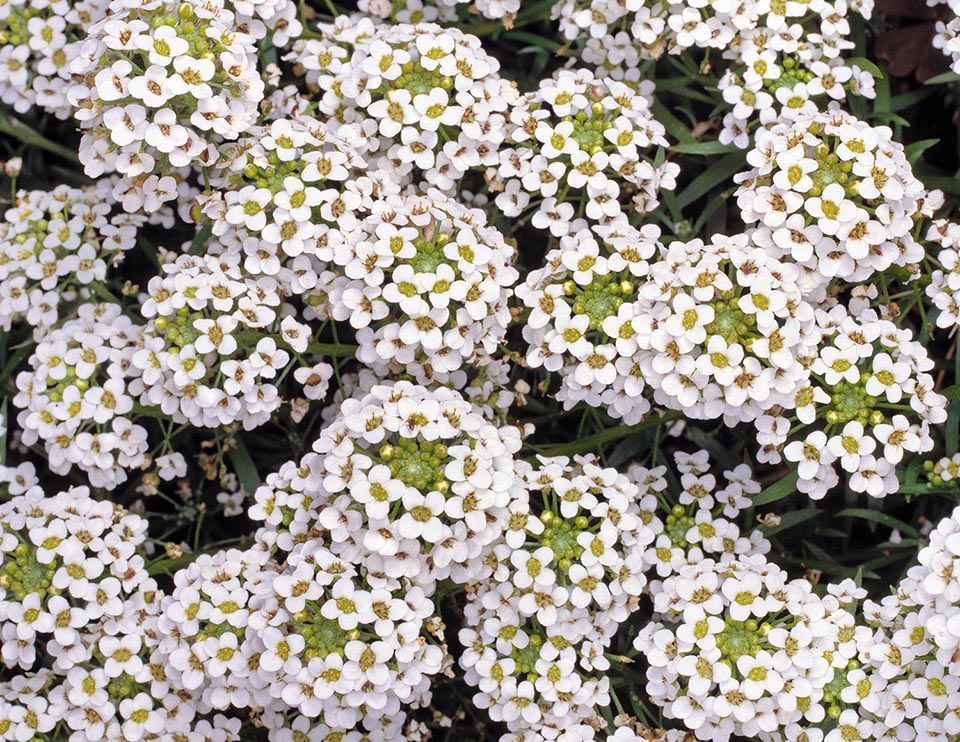
Nowadays are available varieties with big globose inflorescences for flower beds and dwarf varieties © Giuseppe Mazza
Lobularia maritima is a plant rather resistant to the diseases but may be attacked by cochineals and aphids that spoil the flowers and the leaves. To eliminate the parasites from the plants cultivated in potsid to be used a damp sponge, whilst the plants in open ground are to be treated with specific antiparasitics. The young plants may be attacked by the snails and to prevent their damage the ground around the plant must be spread with diatomaceous earth. The warm days and the cool nights favour the development of the Peronospora that causes depigmentation borne by the foliar tissues that appear of pale green colour and later yellow followed by more or less extended.
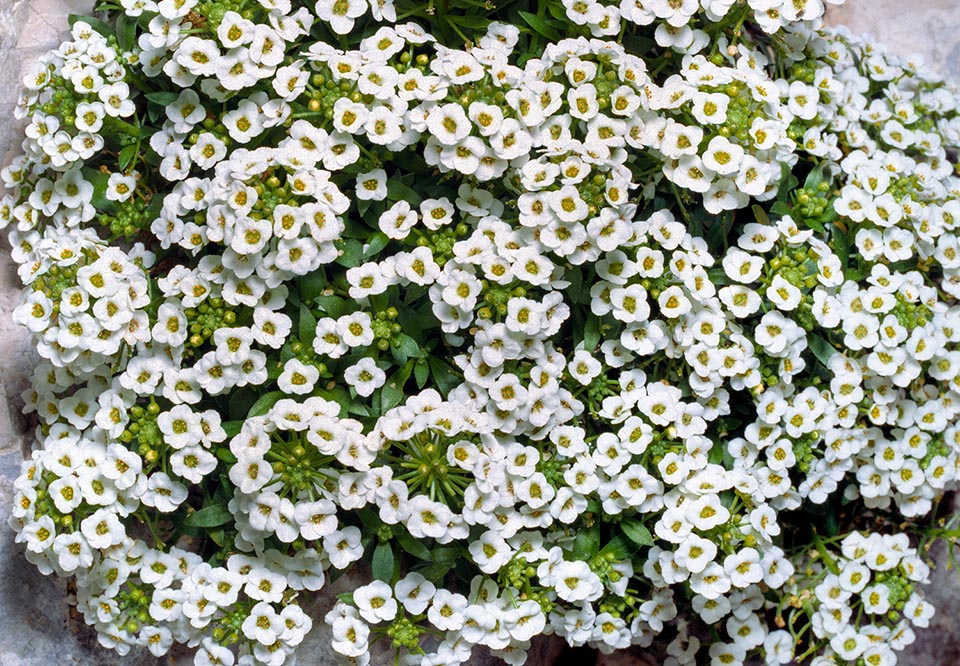
It’s a species easy to grow, resistant to drought. The irrigations are therefore to be given only in summer with a dry soil © Giuseppe Mazza
Synonyms: Alyssum halimifolium L., Alyssum jonasianum H.J. Coste & Sennen, Alyssum maritimum (L.) Lam., Alyssum minimum L., Alyssum odoratum Voss, Alyssum strigulosum (Kunze) Amo, Aurinia halimifolia (L.) Cullen & T.R. Dudley, Clypeola maritima L., Hormathophylla halimifolia (L.) P. Küpfer, Koniga maritima (L.) R. Br., Koniga strigulosa (Kunze) Nyman, Lepidium angustifolium Rusby, Lepidium fragrans Willd., Lobularia strigulosa (Kunze) Willk., Lunaria halimifolia (L.) All., Ptilotrichum halimifolium (L.) Boiss., Ptilotrichum strigulosum Kunze.
→ For general notions about BRASSICACEAE please click here.
→ To appreciate the biodiversity within the BRASSICACEAE family please click here.
